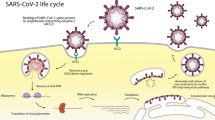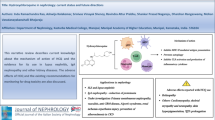Abstract
Experimental autoimmune nephritis in mice and spontaneous lupus nephritis are both associated with elevated expression of several chemokines in the kidneys. Nevertheless, the role that different chemokines play in mediating renal inflammation is far from complete. This study focuses on elucidating the functional role of RANTES, a chemokine that has been noted to be hyper-expressed within the kidneys, both in experimental renal disease as well as in spontaneous lupus nephritis. To elucidate if RANTES was essential for immune-mediated glomerulonephritis, DBA/1 mice that are highly sensitive to nephrotoxic serum nephritis were rendered RANTES-deficient and then tested for disease susceptibility. Nephritis-sensitive DBA/1 mice expressed more RANTES within the diseased kidneys. Compared to wild-type DBA/1 mice, RANTES-deficient DBA/1 mice developed significantly less proteinuria, azotemia, and renal inflammation, with reduced crescent formation and tubulo-interstitial nephritis. These findings indicate that RANTES ablation attenuates immune-mediated nephritis and suggest that this chemokine could be a potential therapeutic target in these diseases.






Similar content being viewed by others
Abbreviations
- NTN:
-
Nephrotoxic serum nephritis
- GBM:
-
Glomerular basement membrane
- NTS:
-
Nephrotoxic sera
- GN:
-
Glomerulonephritis
References
Schall TJ, Jongstra J, Dyer BJ, Jorgensen J, Clayberger C, Davis MM, et al. A human T cell-specific molecule is a member of a new gene family. J Immunol. 1988;141:1018–25.
Schall TJ. Biology of the RANTES/SIS cytokine family. Cytokine. 1991;3:165–83.
Brown KD, Zurawski SM, Mosmann TR, Zurawski G. A family of small inducible proteins secreted by leukocytes are members of a new superfamily that includes leukocyte and fibroblast-derived inflammatory agents, growth factors, and indicators of various activation processes. J Immunol. 1989;142:679–87.
Schall TJ, Bacon K, Toy KJ, Goeddel DV. Selective attraction of monocytes and T-lymphocytes of the memory phenotype by cytokine RANTES. Nature. 1990;347:669–71.
Robinson E, Keystone EC, Schall TJ, Gillett N, Fish EN. Chemokine expression in rheumatoid arthritis (RA): evidence of RANTES and macrophage inflammatory protein (MIP)-1 beta production by synovial T cells. Clin Exp Immunol. 1995;101:398–407.
Rathanaswami P, Hachicha M, Sadick M, Schall TJ, McColl SR. Expression of the cytokine RANTES in human rheumatoid synovial fibroblasts. Differential regulation of RANTES and interleukin-8 genes by inflammatory cytokines. J Biol Chem. 1993;268(8):5834–9.
Volin MV, Shah MR, Tokuhira M, Haines GK, Woods JM, Koch AE. RANTES expression and contribution to monocyte chemotaxis in arthritis. Clin Immunol Immunopathol. 1998;89:44–53.
Shahrara S, Proudfoot AE, Woods JM, Ruth JH, Amin MA, Park CC, et al. Amelioration of rat adjuvant-induced arthritis by Met-RANTES. Arthritis Rheum. 2005;52:1907–19.
Plater-Zyberk C, Hoogewerf AJ, Proudfoot AE, Power CA, Wells TN. Effect of a CC chemokine receptor antagonist on collagen induced arthritis in DBA/1 mice. Immunol Lett. 1997;57:117–20.
Barnes DA, Tse J, Kaufhold M, Owen M, Hesselgesser J, Strieter R, et al. Polyclonal antibody directed against human RANTES ameliorates disease in the Lewis rat adjuvant-induced arthritis model. J Clin Investig. 1998;101:2910–9.
Okamoto H, Kamatani N. A CCR-5 antagonist inhibits the development of adjuvant arthritis in rats. Rheumatology. 2006;45:230–2.
Snowden N, Hajeer A, Thomson W, Ollier B. RANTES role in rheumatoid arthritis. Lancet. 1994;343:547–8.
Boiardi L, Macchioni P, Meliconi R, Pulsatelli L, Facchini A, Salvarani C. Relationship between serum RANTES levels and radiological progression in rheumatoid arthritis patients treated with methotrexate. Clin Exp Rheumatol. 1999;17:419–25.
Ellingsen T, Buus A, Kuno Mller B, Stengaard-Pedersen K. In vitro migration of mononuclear cells towards synovial fluid and plasma from rheumatoid arthritis patients correlates to RANTES synovial fluid levels and to clinical pain parameters. Scand J Rheumatol. 2000;29:216–21.
Suzuki N, Nakajima A, Yoshino S, Matsushima K, Yagita H, Okumura K. Selective accumulation of CCR5+ T lymphocytes into inflamed joints of rheumatoid arthritis. Int Immunol. 1999;11:553–9.
Proudfoot AEI, Buser R, Borlat F, Alouani S, Soler D, Offord RE, et al. Amino-terminally modified RANTES analogues demonstrate differential effects on RANTES receptors. J Biol Chem. 1999;274:32478–85.
Anders H-J, Vielhauer V, Kretzler M, Cohen CD, Segerer S, Luckow B, et al. Chemokine and chemokine receptor expression during initiation and resolution of immune complex glomerulonephritis. J Am Soc Nephrol. 2001;12:919–31.
Schadde E, Kretzler M, Banas B, Luckow B, Assmann K, Schlondorff D. Expression of chemokines and their receptors in nephrotoxic serum nephritis. Nephrol Dial Transplant. 2000;15:1046–53.
Lloyd CM, Minto AW, Dorf ME, Proudfoot A, Wells TNC, Salant DJ, et al. RANTES and monocyte chemoattractant protein-1 (MCP-1) play an important role in the inflammatory phase of crescentic nephritis, but only MCP-1 Is involved in crescent formation and interstitial fibrosis. J Exp Med. 1997;185:1371–80.
Krensky AM, Ahn Y-T. Mechanisms of disease: regulation of RANTES (CCL5) in renal disease. Nat Clin Pract Nephrol. 2007;3:164–70.
Cockwell P, et al. In situ analysis of C-C chemokine mRNA in human glomerulonephritis. Kidney Int. 1998;54:827–36.
Furuichi K, et al. Distinct expression of CCR1 and CCR5 in glomerular interstitial lesions of human glomerular disease. Am J Nephrol. 2000;20:291–9.
Xie C, Zhou XJ, Liu X, Mohan C. Enhanced susceptibility to end-organ disease in the lupus-facilitating NZW mouse strain. Arthritis Rheum. 2003;48:1080–92.
Xie C, Sharma R, Wang H, Zhou XJ, Mohan C. Strain distribution pattern of susceptibility to immune-mediated nephritis. J Immunol. 2004;172:5047–55.
Fu Y, Du Y, Mohan C. The experimental anti-GBM model as a tool for studying spontaneous lupus nephritis. Clin Immunol. 2007;124:109–18.
Tipping PG, Kitching AR. Glomerulonephritis, Th1 and Th2: what's new? Clin Exp Immunol. 2005;142(2):207–15.
Chan RW, Lai FM, Li EK, Tam LS, Chow KM, Li PK, et al. Messenger RNA expression of RANTES in the urinary sediment of patients with lupus nephritis. Nephrology (Carlton). 2006;11(3):219–25.
Eriksson C, Eneslatt K, Ivanoff J, Rantapaa-Dahlqvist S, Sundqvist KG. Abnormal expression of chemokine receptors on T-cells from patients with systemic lupus erythematosus. Lupus. 2003;12(10):766–74.
Kaneko H, Ogasawara H, Naito T, Akimoto H, Lee S, Hishikawa T, et al. Circulating levels of beta-chemokines in systemic lupus erythematosus. J Rheumatol. 1999;26(3):568–73.
Moore KJ, Wada T, Barbee SD, Kelley VR. Gene transfer of RANTES elicits autoimmune renal injury in MRL-Fas(1pr) mice. Kidney Int. 1998;53(6):1631–41.
Gao P, Zhou X-Y, Yashiro-Ohtani Y, Yang Y-F, Sugimoto N, Ono S, et al. The unique target specificity of a nonpeptide chemokine receptor antagonist: selective blockade of two Th1 chemokine receptors CCR5 and CXCR3. J Leukoc Biol. 2003;73:273–80.
Panzer U, Schneider A, Wilken J, Thompson DA, Kent SB, Stahl RA. The chemokine receptor antagonist AOP-RANTES reduces monocyte infiltration in experimental glomerulonephritis. Kidney Int. 1999;56:2107–15.
Anders HJ, et al. CC chemokine ligand 5/RANTES chemokine antagonists aggravate glomerulonephritis despite reduction of glomerular leukocyte infiltration. J Immunol. 2003;170:5658–66.
Anders HJ, Vielhauer V, Frink M, Linde Y, Cohen CD, Blattner SM, et al. A chemokine receptor CCR-1 antagonist reduces renal fibrosis after unilateral ureter ligation. J Clin Investig. 2002;109:251–9.
Anders HJ, Belemezova E, Elis V, Segerer S, Vielhauer V, Frink M, et al. Late onset of treatment with a chemokine receptor CCR1 antagonist prevents progression of lupus nephritis in MRL-FASlpr mice. J Am Soc Nephrol. 2004;15:1504–13.
Eia V, Luckow B, Vielhauer V, Siveke JT, Linde Y, Sergere S, et al. Chemokine receptor CCR1 but not CCR5 mediates leukocyte recruitment and subsequent renal fibrosis after unilateral ureteral obstruction. J Am Soc Nephrol. 2004;15:337–47.
Turner J-E, Paust H-J, Steinmetz OM, Peters A, Meyer-Schwesinger C, Heymann F, et al. CCR5 deficiency aggravates crescentic glomerulonephritis in mice. J Immunol. 2008;181:6546–56.
Ye DQ, et al. Polymorphisms in the promoter region of RANTES in Han Chinese and their relationship with systemic lupus erythematosus. Arch Dermatol Res. 2005;297:108–13.
Mlynarski WM, et al. Risk of diabetic nephropathy in type I diabetes is associated with functional polymorphisms in RANTES receptor gene (CCR5): a sex-specific effect. Diabetes. 2005;54:3331–5.
Author information
Authors and Affiliations
Corresponding authors
Additional information
This work is supported in part by the NIH grants RO1 AR50812, as well as the National Arthritis Foundation.
Rights and permissions
About this article
Cite this article
Xie, C., Liu, K., Fu, Y. et al. RANTES Deficiency Attenuates Autoantibody-Induced Glomerulonephritis. J Clin Immunol 31, 128–135 (2011). https://doi.org/10.1007/s10875-010-9470-x
Received:
Accepted:
Published:
Issue Date:
DOI: https://doi.org/10.1007/s10875-010-9470-x




